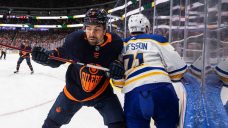EDMONTON — Here’s the thing about “team toughness,” and “being hard to play against.”
They are real, even if unquantifiable, and their definitions are ever changing as the game evolves. The more it evolves, however, the more it divides, as the analytics and “eye test” sets move further apart on a topic that you can’t put a number on — unless you’re counting playoff rounds won.
Let’s start in Edmonton, where the top half of the lineup has more than enough skill. But we would question, does the bottom half make their opponents work hard enough for what they get?
Could the Edmonton Oilers, as a team, be harder to play against?
“I think in certain areas, at certain times we could be,” allowed winger Evander Kane, who is undoubtedly Edmonton’s toughest, most physically intimidating forward. “You can always be harder. If we look at some of the opportunities we gave up over these first three games, (being harder) was the focal point and will be a focal point as we continue.
“Playing a tough team like Carolina (on Thursday night) we’re going have to be hard because they have a lot of guys that play hard around net on both ends.”
If we can all agree that the term “toughness” no longer embodies the ability or willingness to drop the gloves and fight — “I agree,” said Oilers head coach Jay Woodcroft — then how do we define “being hard to play against” here in the year 2022?
“Choosing hard is a form of toughness,” explained Woodcroft. “Sometimes the play to be made is a hard play. It might be a 50/50 puck battle. It might be getting the puck out along the wall under pressure. It might be going to the blue paint with authority in the offensive zone. It might be defending the blue paint in your own zone with authority.”
In overtime of Game 5 in Round 2 versus Calgary, Leon Draisaitl emerged from the corner with the puck and took a stride up the wall. Johnny Gaudreau had a split second to decide whether to engage and impede Draisaitl. He instead chose to loop up the wall towards the Oilers defenceman.
Draisaitl fed Connor McDavid and the series was over, closing on a very soft play by the Flames player.
When the teams met in Game 2 of the season, two Calgary goals came from players who stood in Edmonton’s low slot, waiting until their opportunity arrived.
They showed the willingness to go to that “hard place” and set up shop, while Edmonton’s players chose not to make that area a “hard place” at all.
The Oilers were the soft team on this night, and they lost. They lost again the next game, on two Buffalo goals in the second period that a harder defensive mindset might have prevented.
So, let’s look at Edmonton’s roster:
At Top 6 left wing, Kane and Zach Hyman both have good size and are hard to play against. At centre, McDavid and Draisaitl both have size, willingness to engage, unbelievable skill and are highly competitive. On the right side, though small, Yamamoto is a battler. Jesse Puljujarvi is a big body, though not overly physical.
On line three — either sophomore Ryan McLeod or rookie Dylan Holloway, with Ryan Nugent-Hopkins and Warren Foegele — it drops off.
Third lines are traditionally stocked with bigger players who create energy through body contact, cycling and protecting pucks down low to create zone time while the Top 6 guys get a rest. This unit does not thrive at any of those things.
Nugent-Hopkins is a lighter, cerebral player. Nothing in his game brings the word “punishing” to mind.
Foegele skates fast but doesn’t hit much. He neither intimidates nor frustrates, in the way some third lines can shut down the opponent’s top unit.
Holloway is a rookie. He’s still learning the game. McLeod is fast but not yet physical.
Among Edmonton’s fourth-liners — Derek Ryan, Devin Shore, Brad Malone — there is skill, but not a ton of size or physicality. It’s an overall skill-based lineup that will beat you 5-4, but may not win enough 3-2 games to get through three playoff rounds again this spring.
On defence, Darnell Nurse and Cody Ceci have considerable grit — again, a term the Fancy Stats folks deride. But then Montreal makes it to a Cup final with four big, abrasive defencemen, and the skill-based, grit-challenged Maple Leafs — a team built heavily on analytics — haven’t won a playoff round in forever.
Below the top pair, Evan Bouchard, Tyson Barrie, Brett Kulak and either Ryan Murray or Philip Broberg do not make for a hard group. Which is why we’d be playing Markus Niemelainen, who brings a very physical side to the mix.
But it’s 2022, and maybe we’re just a dinosaur.
Heck, Woodcroft calls his powerplay “a form of toughness.”
“I do think the power play is a way to keep the flies off, so to speak,” he said. “I saw Warren Foegele stick up for a teammate (Dylan Holloway) yesterday. I thought that was a form of team toughness. I think we have more than enough people that are capable of taking care of themselves or the ability to take care of teammates that may be put in a vulnerable situation.
“You want to have a type of pack mentality where nobody gets taken advantage of. But at the same time, I think that's developed over a season as a team comes together.”
Look, no coach is going to come out in October and question whether his team has the size and grit it needs. So we’ll watch.
Does Niemelainen get into the lineup?
Does the general manager make a depth trade or two? What kind of defenceman does Ken Holland retrieve at the trading deadline?
Their actions will tell you if we’re barking up the right tree.
As of today, this Oilers lineup has a lot of positive things. But they’re not hard enough to play against, and that could be the difference when push comes to shove.








COMMENTS
When submitting content, please abide by our submission guidelines, and avoid posting profanity, personal attacks or harassment. Should you violate our submissions guidelines, we reserve the right to remove your comments and block your account. Sportsnet reserves the right to close a story’s comment section at any time.